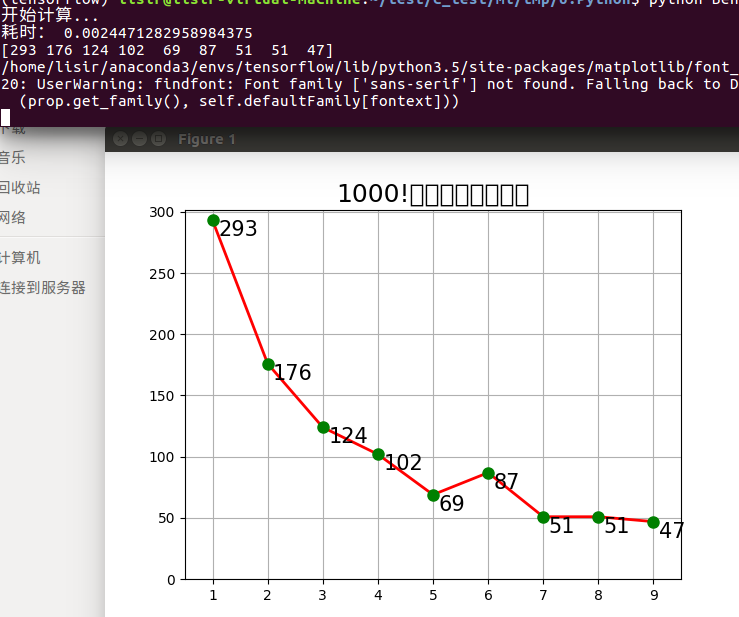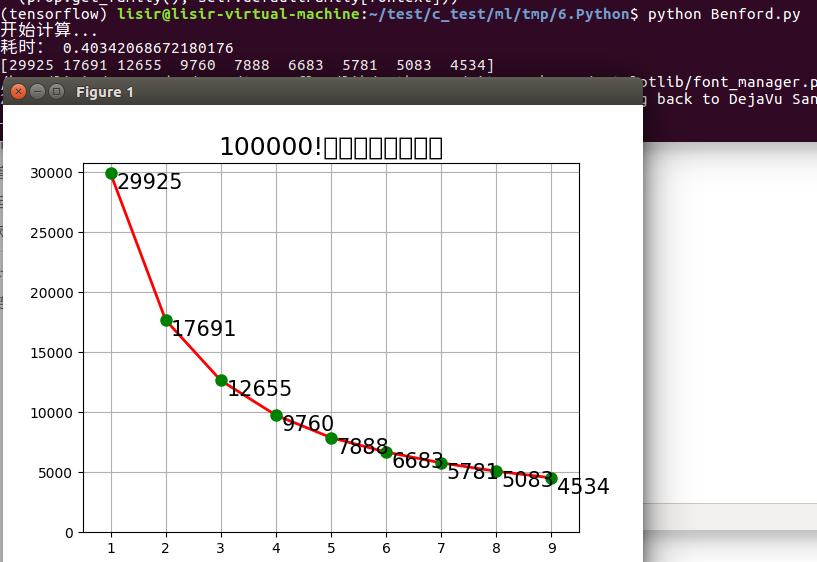概率论给予了我们现实生活直观感觉完全不一样的解释,现实生活中的本福特定律就是一个很好的例子:
就像我们对考第一名印象很深刻,但是之后的第二第三就不怎么去留意;奥运冠军也是一样,所有人都会记得冠军是谁,但是亚军和季军就很少有人想的起来.
这里用python求出阶乘的数值中末尾或者首位出现0-9这10个数字的频率统计,其实(频数/总数)也可近似就是概率:
# -*- coding:utf-8 -*-
# /usr/bin/python
import numpy as np
import matplotlib as mpl
import matplotlib.pyplot as plt
from time import time
from scipy.special import factorial
import math
mpl.rcParams['axes.unicode_minus'] = False
mpl.rcParams['font.sans-serif'] = 'SimHei'
def top1(number, a):
number /= a
while number >= 10:
number /= 10
a *= 10
return number, a
def top2(number, N2):
while number >= N2:
number /= 10
n = number
while number >= 10:
number /= 10
return n, number
def top3(number):
number -= int(number)
return int(10 ** number)
def top4(number):
number -= int(number)
frequency[int(10 ** number) - 1] += 1
if __name__ == '__main__':
N = 100000
x = range(1, N+1)
frequency = np.zeros(9, dtype=np.int)
f = 1
print('开始计算...')
t0 = time()
'''
# top1
a = 1
for t in x:
f *= t
i, a = top1(f, a)
print(t, i, f, a)
frequency[i-1] += 1
t1 = time()
print('1耗时:', t1 - t0)
# print(frequency)
# top2
N2 = N ** 3
for t in x:
f *= t
f, i = top2(f, N2)
frequency[i-1] += 1
t2 = time()
print('2耗时:', t2 - t1)
# print(frequency)
# Top 3:实现1
f = 0
for t in x:
f += math.log10(t)
frequency[top3(f) - 1] += 1
t3 = time()
print('3_1耗时:', t3 - t2)
# print(frequency)
# Top 3:实现2
y = np.cumsum(np.log10(x))
for t in y:
frequency[top3(t) - 1] += 1
t4 = time()
print('3_2耗时:', t4 - t3)
# print(frequency)
# Top 4:本质与Top3相同
y = np.cumsum(np.log10(x))
map(top4, y)
'''
# Top 3:实现2
y = np.cumsum(np.log10(x))
for t in y:
frequency[top3(t) - 1] += 1
t5 = time()
print('耗时:', t5 - t0)
print(frequency)
t = np.arange(1, 10)
plt.plot(t, frequency, 'r-', t, frequency, 'go', lw=2, markersize=8)
for x,y in enumerate(frequency):
plt.text(x+1.1, y, frequency[x], verticalalignment='top', fontsize=15)
plt.title(u'%d!首位数字出现频率' % N, fontsize=18)
plt.xlim(0.5, 9.5)
plt.ylim(0, max(frequency)*1.03)
plt.grid(b=True)
plt.show()
# 使用numpy
# N = 170
# x = np.arange(1, N+1)
# f = np.zeros(9, dtype=np.int)
# t1 = time()
# y = factorial(x, exact=False)
# z = map(top, y)
# t2 = time()
# print '耗时 = \t', t2 - t1
# for t in z:
# f[t-1] += 1
# print f
























 1049
1049

 被折叠的 条评论
为什么被折叠?
被折叠的 条评论
为什么被折叠?








